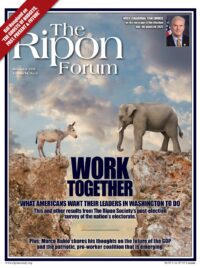
Few things about the 2020 election in Northampton County, Pennsylvania could be considered ordinary. Voters in this mid-sized county on the eastern edge of the Keystone State made their election choices in the midst of a historic pandemic, and for the first time since its founding in 1752, a large portion of the county’s residents cast their ballots by mail. While by many standards 2020 was like no other election experienced in Northampton County, one important electoral dimension that was strikingly ordinary was the County’s ability to serve as a bellwether for how Pennsylvania would go in the Presidential race.
Since 1920, the winner of the presidential race in Northampton County has also won the race in Pennsylvania in all but one election (1944). And so it was again in 2020, as former Vice President Joe Biden beat President Donald Trump by less than 1 percent, or about 1,200 votes out over 171,000 cast. Four years earlier, Trump has carried Northampton County by a 4 percent margin, becoming the first Republican presidential candidate to do this since 1988, as he narrowly won Pennsylvania and its bounty of 20 Electoral College votes. What was different in NorCo in 2020 from 2016, and what do the results in 2020 tell us about politics in Pennsylvania moving forward?
As was the case in much of the country, suburban voters in Northampton County played a major role in flipping this key region of the Commonwealth from Trump in 2016 to Biden in 2020. In highly educated, upper income suburbs such as Forks and Hanover Townships, Biden cruised to victories in areas Trump either won, or narrowly lost, four years earlier. While Biden’s victories in the urban centers of Bethlehem and Easton, and improved performance over Clinton’s results in small towns (boroughs) such a Nazareth and Hellertown, were certainly crucial in his victory, the suburbs delivered the biggest blow to Trump’s effort to repeat his 2016 success. These major gains turned out to be essential for Biden, as the President increased his yield in Northampton’s many rural townships, elevating his overall vote total in the county by nearly 12,000 votes over 2016.
Trump’s inability to repeat in Northampton County was undoubtedly affected by intense dissatisfaction with his handling of the COVID-19 pandemic.
Trump’s inability to repeat in Northampton County was undoubtedly affected by intense dissatisfaction with his handling of the COVID-19 pandemic. In a fall survey from Muhlenberg College, a majority (51%) of likely voters in Norco rated the President’s handling of the pandemic as “poor.” With this issue among the top three concerns of voters in the cycle (along with the economy and health care), having a majority of voters give the President the worst possible rating on his handling of a highly salient issue clearly undercut his reelection chances. Notably, Northampton voters were largely buying the President’s economic pitch, with 4 out of 10 saying they were better off financially since Trump took office, compared to only about 1 in 10 that said their financial standing was worse.
As noted earlier, for the first time in its long history, Northampton County had a large portion of its residents cast ballots by mail. Nearly 43% of voters in this key swing county chose to make their choices through the mail-in method. In the past, only a sliver of citizens in NorCo voted via mail. But a 2019 law passed by the Republican-controlled state legislature gave voters easy access to this method, and more than 4 in 10 local voters utilized the option. While it’s hard to determine if all those that chose to vote by mail would have voted in person if the mail option was not available, it’s clear that Biden supporters turned to this option much more than Trump voters. Among those voting by mail, Biden won by a 3 to 1 margin.
While it’s hard to determine if all those that chose to vote by mail would have voted in person if the mail option was not available, it’s clear that Biden supporters turned to this option much more than Trump voters.
The results in Northampton County also suggested the fairly solid performance Republicans would have down ballot across Pennsylvania, and in many other states. Norco voters turned to GOP candidates for Pennsylvania’s Treasurer and Auditor General offices, helping to secure Republican victories in these seats for the first time in nearly two decades. And while Republicans were unable to knock off Democrat Susan Wild, the Lehigh Valley’s first-term Congresswomen, the GOP’s nominee, Lisa Scheller, did narrowly carry Northampton County in her narrow 4-point loss to Wild. This tight race may have made a 2022 rematch between Wild and Scheller quite likely, if the 7th Congressional District is kept largely intact after the upcoming redistricting in which Pennsylvania is likely to lose one of its 18 House seats.
With its status as one of the nation’s premiere bellwether counties cemented for four more years, Northampton County enters the new decade with both Democrats and Republicans optimistic that they are primed for a successful stretch. The national spotlight won’t be focused on NorCo in 2021, but next November’s off-year elections may tell us more about what the lessons of the 2020 elections really were.
Christopher P. Borick, Ph.D., is a Professor of Political Science and the Director of the Muhlenberg College Institute of Public Opinion. This is the third in a series of essays about Northampton County that Professor Borick has authored for the Forum since the 2016 election.




